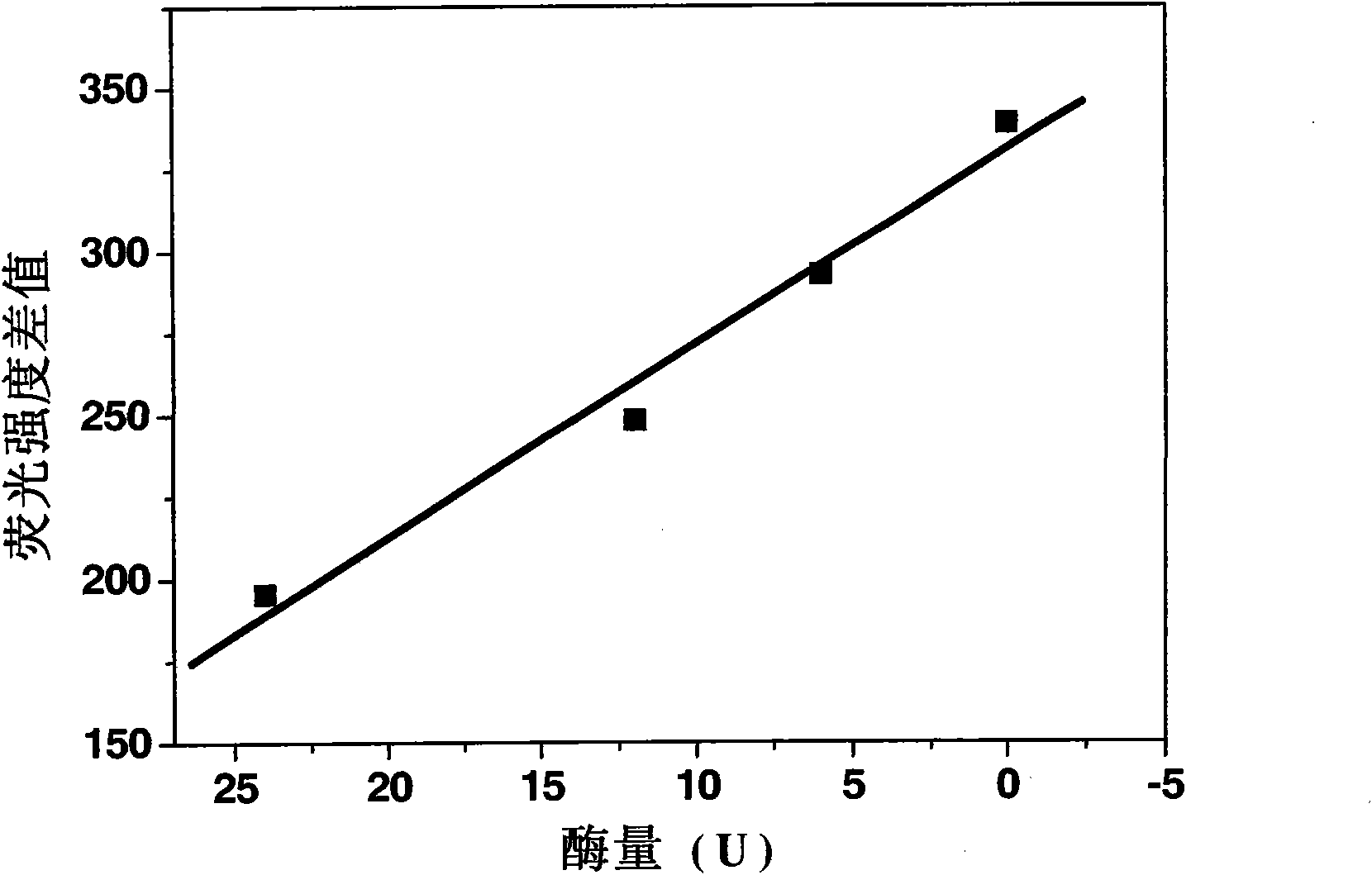Enzyme chip based on quantum dot fluorescence detection, preparation method and application
A fluorescence detection, quantum dot technology, applied in fluorescence/phosphorescence, analysis by chemical reaction of materials, material excitation analysis, etc., can solve problems such as detection of enzyme-based disease markers that have not been reported.
- Summary
- Abstract
- Description
- Claims
- Application Information
AI Technical Summary
Problems solved by technology
Method used
Image
Examples
Embodiment 1
[0063] 1. Preparation of cadmium telluride quantum dots (prepared with reference to CN 200810101429.4),
[0064] (1) Add cadmium nitrate and thioglycolic acid in sequence in deionized water, so that the molar ratio of cadmium nitrate and thioglycolic acid is 1:50. After the complexation reaction is completed, add sodium hydride telluride equimolar to cadmium nitrate to obtain water-soluble quantum point precursor solution, the final concentration of cadmium ion is 10 -5 M;
[0065] (2) Add the precursor solution obtained in step (1) to an ultrasonic atomizer. After ultrasonic atomization, the precursor solution exists in the form of submicron droplets to obtain the precursor solution of water-soluble quantum dots. mist;
[0066] (3) Feed in nitrogen, the flow rate of nitrogen gas is 5L / min, and the droplets of the precursor solution obtained in step (2) are brought into the temperature-stabilized reaction device, and the droplets of the precursor solution are heated (the tem...
Embodiment 2
[0079] 1. The preparation of cadmium telluride quantum dots is the same as in Example 1.
[0080] 2. The substrate of the enzyme chip was fabricated by mask photolithography technology as in Example 1, and the side length of the prepared substrate microchamber was 30 mm.
[0081] 3. Using an enzyme chip to detect the activity of lactate dehydrogenase:
[0082] (1) Preparation of the agar solution: dissolve the agar in water to obtain the agar solution, the concentration of the agar is 5% by weight, and the water temperature is 70°C. Inject agar solution into each microchamber on the substrate made in step 2, cool to room temperature, and form a layer of agar gel at the bottom of the microchamber;
[0083] (2) Prepare the quantum dot solution: disperse the cadmium telluride quantum dots in 0.01 mol / liter phosphate buffer (pH 6.8) to obtain the cadmium telluride quantum dot solution, and the telluride in the cadmium telluride quantum dot solution The molar concentration of cad...
Embodiment 3
[0090] 1. Preparation of cadmium telluride quantum dots (prepared with reference to CN 200810101429.4)
[0091] (1) Add cadmium nitrate and thioglycolic acid sequentially in deionized water, so that the molar ratio of cadmium nitrate and thioglycolic acid is 1:3. After the complexation reaction is completed, add sodium hydride telluride equivalent to cadmium nitrate to obtain water-soluble quantum point precursor solution, the final concentration of cadmium ions was 5×10 -2 M;
[0092] (2) Add the precursor solution obtained in step (1) to an ultrasonic atomizer. After ultrasonic atomization, the precursor solution exists in the form of submicron droplets to obtain the precursor solution of water-soluble quantum dots. mist;
[0093] (3) Feed nitrogen, the flow rate of nitrogen is 3L / min, the droplets of the precursor solution obtained in step (2) are brought into the temperature-stabilized reaction device, and the droplets of the precursor solution are heated (the temperatur...
PUM
 Login to View More
Login to View More Abstract
Description
Claims
Application Information
 Login to View More
Login to View More - R&D
- Intellectual Property
- Life Sciences
- Materials
- Tech Scout
- Unparalleled Data Quality
- Higher Quality Content
- 60% Fewer Hallucinations
Browse by: Latest US Patents, China's latest patents, Technical Efficacy Thesaurus, Application Domain, Technology Topic, Popular Technical Reports.
© 2025 PatSnap. All rights reserved.Legal|Privacy policy|Modern Slavery Act Transparency Statement|Sitemap|About US| Contact US: help@patsnap.com



